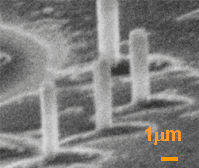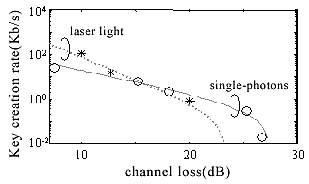Physical Science Laboratory
Å@Quantum cryptography, which guarantees unconditional security based on the law of quantum mechanics, is extensively studied. It is a system that provides a secret key for ciphering messages to two legitimate parties, utilizing the fact that non-orthogonal quantum states cannot be fully identified by an eavesdropper. Several experiments have been demonstrated, using attenuated laser light with an average photon number of, for example, 0.1 per pulse. However, the photon number statistics of laser light follows the Poisson distribution, and there is a finite probability of two photons in one pulse, from which an eavesdropper can steal a part of information. It is known that the amount of leaked information is larger for larger transmission loss. Thus, experiments using a single-photon source, that emits no more than two photons per pulse, are desired for long-distance systems. We successfully demonstrated a quantum cryptography experiment using a single-photon source for the first time.
Å@The photon source was an InAs semiconductor quantum dot fabricated at Stanford University. In order to extract photons efficiently, the dot was embedded in a post-shaped microcavity (Fig. 1). When illuminated by pump pulses, it emitted one photon per pulse via spontaneous emission between particular energy levels. The emission efficiency was 6 %, and the probability that it emitted two photons per pulse was one tenth of conventional laser light. Using this light source, we carried out an quantum cryptography experiment based on the uncertainty among four polarization states (called BB84), and obtained desired correlation between the transmitter and receiver with an error rate of 2.5 %. Then, applying error correction and privacy amplification to these data, we successfully created an unconditionally secured secret key for ciphering messages. The final key creation rate was 25 kbit/s. We also carried out the same experiment for various channel losses between the transmitter and receiver both for our single-photon source and a laser source (Fig. 2). The results showed that, though the key creation rate was lower in the low loss region because of the low emission efficiency, the single-photon source could achieve longer transmission distance than laser light.
[1] E. Waks et al., Nature 420 (2002) 762.
 |
 |
||||
|
|